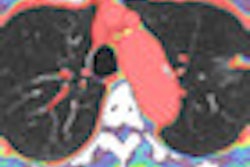Individual medical histories affect how much ionizing radiation poor people accumulate from medical imaging more than their socioeconomic status, according to a mammoth study of poverty and medical practice performed at New York City's Montefiore Medical Center.
Public health officials have long known that bad health can lead a person into poverty. And they have recently speculated that those in the lowest economic rungs of society are exposed to more ionizing radiation than more advantaged classes, noted Daniel Strauchler, a medical student, during a presentation at the 2010 RSNA meeting.
Theories to explain the poor's higher cumulative radiation dose have ranged from a lack of access to MRI and diagnostic ultrasound, two modalities that do not involving ionizing radiation, to patient ignorance about radiation risks, as well as the absence of a personal physician to monitor patient histories of medical imaging.
A few studies performed outside the U.S. have examined the topic. A Canadian study in 2005 found that prosperous individuals there tended to receive more radiological exams than poor people, but the relative risks for the middle and upper classes were lower because they were more likely to receive MRI or ultrasound. A 2008 study from Taiwan, a country with government-sponsored health insurance, revealed that lower socioeconomic status was associated with a relatively higher rate of CT use.
But no comparable study had been performed in the U.S. until the Montefiore researchers, led by Todd Miller, MD, an assistant professor of radiology, analyzed the clinical experiences of New Yorkers who live in impoverished neighborhoods of the Bronx and were diagnosed and treated at the nearby 1,400-bed teaching hospital. Strauchler was part of the research team.
Miller and colleagues followed the nonemergency clinical experiences of 54,530 patients after an initial outpatient visit to Montefiore in January 2006. Cumulative radiation exposures were tabulated for each patient according to individual medical imaging experiences and published calculations of radiation exposure for specific types of exams. Elixhauser's diagnoses based on ICD-9 codes were used to identify comorbidity.
An analysis of the resulting data identified no association between poverty levels and the cumulative radiation received by children, adult men, and most adult women, Strauchler said. Large statistical standard deviations indicated a few patients were exposed to large amounts of radiation.
The researchers found that 8,155 patients from ages 10 to 21 were exposed to a mean dose of 1.1 mSv, with a standard deviation of 9.5. The 10,908 children younger than 10 years received a mean dose of 0.45 mSv, with a standard deviation of 7.19.
Among adults, 3,194 women ages 22 to 30 received a mean dose of 3.1 mSv, with a standard deviation of 12.69. The 4,020 women ages 31 to 40 were exposed to a mean dose of 4.51 mSv, with a standard deviation of 16.45.
The experiences of fewer male men were available, suggesting they have less access to acute care services than other populations, Strauchler noted. Excluding breast and emergency room imaging, poor adult women were three times more likely to have a history of medical imaging at Montefiore than adult men.
The mean radiation exposure for men ages 31 to 40 was 4.07 mSv, with a standard deviation of 12.78. For men ages 22 to 30, the mean exposure was 2.77 mSv, with a standard deviation of 12.25.
However, the amount of radiation any one patient received had more to do with his or her health than socioeconomic status, Strauchler said.
Correlations were established between the diseases typically diagnosed or monitored with an imaging exam involving ionizing radiation and lower socioeconomic class.
Coagulopathy exposed poor patients ages 21 or younger to the most radiation -- the group received a mean dose of 15.59 mSv. Other notable contributors included complicated hypertension, hemiplegia or paraplegia, and fluid/electrolyte disorders.
For adult women ages 22 to 40, hemiplegia or paraplegia generated the highest exposures, with a mean dose of 45.43 mSv. Other important sources were rheumatoid arthritis, coagulopathy, and diabetes without complications.
For adult men ages 22 to 40, imaging related to fluid and electrolyte disorders led to the highest mean exposures, with a mean dose of 24.88 mSv. Cardiovascular disease, coagulopathy, and drug abuse also contributed to their radiation burden.
"When put all together, poor people are sicker, and sicker people get more imaging and are exposed to more ionizing radiation," Miller said in a phone interview with AuntMinnie.com.
Moreover, socioeconomic status appeared to have no effect on types or frequency of imaging exams performed at Montefiore, Miller noted. Except for one disease involving few patients and possibly affected by sampling error, no association was found between accumulated radiation exposure for specific diseases and a patient's socioeconomic status.
"Their illness dictated the pattern of care. We were quite pleased to be able to show that," Miller said.
By James Brice
AuntMinnie.com contributing writer
February 17, 2011




















